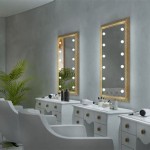How to Turn Glass into a Mirror
Mirrors are ubiquitous in our daily lives, reflecting our images and illuminating our surroundings. While they often appear as commonplace objects, the process of transforming a simple sheet of glass into a reflective surface is fascinating and surprisingly straightforward. This article will delve into the techniques used to turn glass into a mirror, exploring the scientific principles and practical steps involved.
The Science Behind Mirroring
The transformation of glass into a mirror hinges on the principle of reflection. Light, when encountering a surface, can be absorbed, transmitted, or reflected. Mirrors achieve their reflective properties through the application of a thin metallic coating on one side of the glass sheet. The coating, typically made of silver or aluminum, acts as a highly reflective surface, ensuring that most of the incident light is bounced back, creating the familiar mirrored image.
The process generally involves the deposition of a thin layer of the metal onto the glass surface using a technique called vacuum deposition. This method involves heating the metal in a vacuum chamber, causing it to evaporate and condense on the glass sheet. The vacuum environment ensures that the metal particles adhere directly to the glass surface, creating a uniform and highly reflective coating.
Steps Involved in Mirror Making
Turning glass into a mirror involves several steps, each contributing to the final reflective surface. While industrial production employs sophisticated machinery and automated processes, the core principles remain consistent. Here's a breakdown of the major steps:
1. Glass Preparation
The process begins with a thorough cleaning of the glass sheet. This step is critical, as any impurities or contaminants on the glass surface can hinder the adhesion of the reflective coating and compromise the quality of the mirror. The cleaning process typically involves washing the glass with detergents and rinsing it thoroughly with deionized water.
2. Coating Deposition
The next step involves depositing the reflective coating onto the prepared glass surface. As mentioned earlier, this is usually accomplished using vacuum deposition techniques. The glass sheet is placed in a vacuum chamber, and the chosen metal (silver or aluminum) is heated to its evaporation point. The metal vapor condenses on the glass surface, forming a thin and highly reflective layer.
3. Protective Layer
Once the reflective coating is applied, a protective layer is added to shield the metal from oxidation and environmental damage. This layer is often made of copper or paint, and it helps preserve the mirror's reflective properties over time.
4. Backside Treatments
The final stage of mirror making involves treating the backside of the glass sheet. This may include applying a layer of paint or backing paper to improve the mirror's appearance and rigidity. This step also helps prevent moisture from damaging the reflective coating.
Types of Mirrors
The world of mirrors extends beyond the standard flat, reflective surfaces. Different types of mirrors cater to specific applications, each employing unique techniques to achieve their desired properties.
Concave and Convex Mirrors
These mirrors are characterized by their curved surfaces, either inward (concave) or outward (convex). Concave mirrors converge incoming light, creating magnified or focused images, and are commonly used in telescopes and magnifying glasses. Convex mirrors, on the other hand, diverge incoming light, producing a wider field of view and are frequently employed as rearview mirrors in vehicles.
One-Way Mirrors
One-way mirrors, or two-way mirrors, present a unique optical phenomenon. These mirrors are designed to be partially reflective and partially transparent, allowing for different levels of visibility from each side. This effect is achieved by varying the thickness of the reflective coating, giving rise to the illusion of a one-way mirror. They are often used in security settings for covert observation.
Half-Silvered Mirrors
Half-silvered mirrors are similar to one-way mirrors, but with the reflective coating applied to a thin glass plate. This creates a translucent mirror that reflects some light while allowing some to pass through. They are commonly used in optical devices like beam splitters in laser systems.

How To Turn Ordinary Glass Into An Antique Mirror

How To Turn Ordinary Glass Into Looking Interior Frugalista

How To Turn A Vintage Window Into Mirror An Oregon Cottage

How To Turn Ordinary Glass Into An Antique Mirror

I 39 M Going To Show You Guys How Turn Real Glass Into A Mirror Are Need Glas Diy Effect Spray Paint Krylon Looking

Turn Glass Into Mirrors Rustoleum Mirror Effects Spray Paint Effect

How To Turn Ordinary Glass Into Looking Interior Frugalista

How To Turn A Thrifted Picture Frame Into Mirror Sweet Southern Oaks

How To Turn Glass Into An Antique Mirror The Morris Mansion

Turn A Window Into Mirror With Less Than 20 Earlyexperts








